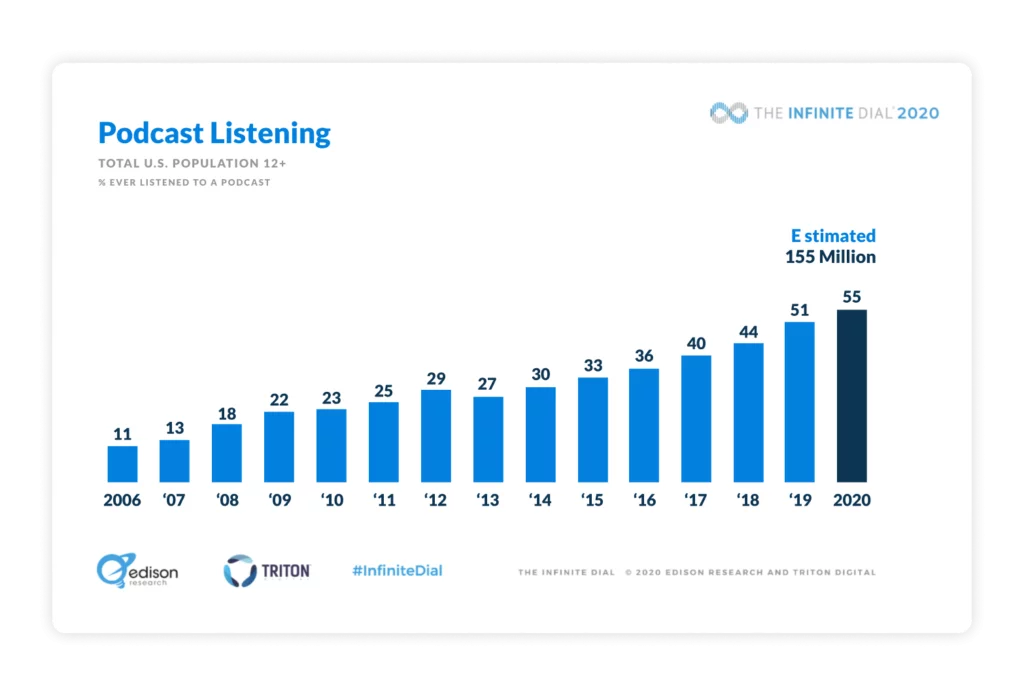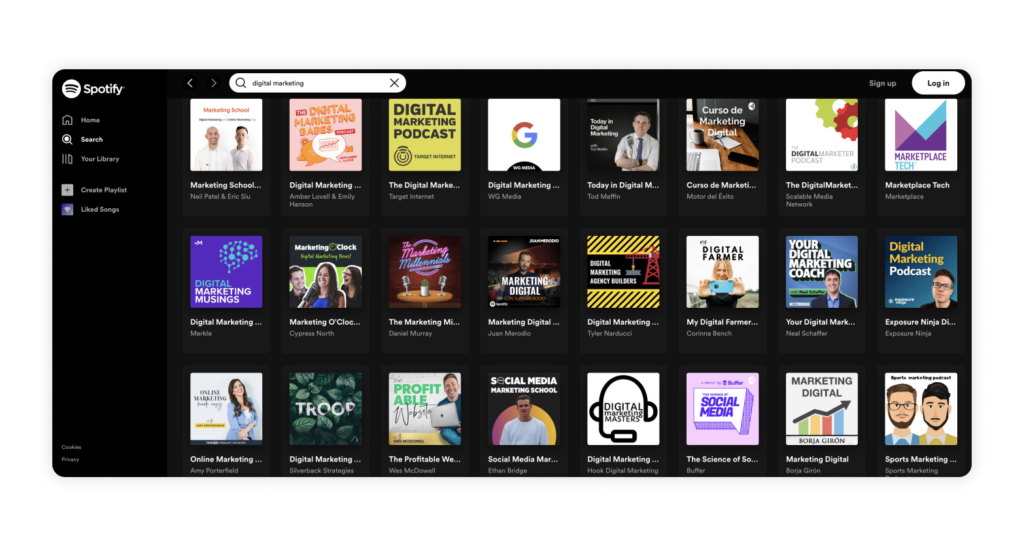
There has been an explosion of multimedia content like podcasts and video over the past decade. Today, people don’t just use Google search. They’re also using the search bar in Spotify and YouTube. There is enormous potential if your content can be found in these search results. Podcasters and video content creators should consider optimizing multimedia content for search.
Multimedia content consumption is on the rise
The amount of video on the internet has skyrocketed over the past decade. In 2007, 6 hours of video was uploaded to YouTube every second. In 2020, that number jumped to 500 hours of video uploaded per second. Social media platforms like TikTok and Instagram have put a major focus on video content.
But video isn’t the only multimedia content format that’s gaining in popularity. According to Edison Research, an estimated 55% of the United States population 12 and older have listened to a podcast (see image below). The same study estimates 24% of the population are weekly listeners and consume more than six hours of podcasts each week. This is supported by the growth of weekly active users on Spotify, which has more than tripled from 132 million in Q1 2017 to 422 million in Q1 2022.

The bottom line is there is growing demand for multimedia content. Algorithms now can index video and audio. This is the perfect storm for creators to increase search visibility on Google and beyond.
How does YouTube index videos for search?
In 2019, Google announced their ability to index the spoken word, not just transcripts. That means that they can reference audio and video content to serve in the results for various search queries on both Google’s main search bar as well as within YouTube.
Listen to this episode of the Digital Marketing Troop podcast, where I talked with John Tyreman about the role of video and audio content in the future of SEO.
YouTube SEO checklist
First, video isn’t right for everyone. It can be a game changer for the right business, though. For instance, the home services space is great for video content. Homeowners often search YouTube for do-it-yourself instructional videos for fixing appliances and leaky sinks.
Here are a few pointers for optimizing your videos for search:
- Create a narration outline for your videos. Work in keywords from research. This helps search engines crawl and index the audio from your videos to be seen in search results.
- Make sure your audio is clear. While a microphone is important, most of this relies on the speaker themself. Consider fine-tuning your speaking skills or hiring a professional narrator.
- Optimize the technical aspects of your video; title, description, and appropriate tags. Be sure to include outward links to your site and make sure your video is not age gated (if content is age-appropriate).
If this is overwhelming, that’s ok. There are a lot of details when it comes to optimizing multimedia content. You can learn it fairly quickly as you accumulate experience, or you can hire a professional that offers YouTube SEO services.
Podcast SEO for audio content
There are over 2 million podcasts available to listeners. That pales in comparison to blogs, which are over 500 million strong. There are 250 times more blogs than podcasts. There is a huge opportunity for companies to invest in this type of content and reach users organically — one of the many benefits of a podcast for business.
Podcast SEO is the process of structuring your audio content so they can be crawled and indexed by major podcast platforms. This increases the visibility of your content when users use the search bar in Spotify, Apple, YouTube, or any major podcasting platform. Here’s an example of what search results look like when you search for “digital marketing” in Spotify podcasts.

In 2017, Google was indexing podcasts and displaying them in the SERP based on meta descriptions and title tags alone. However, as mentioned above, Google gained the capability to index the spoken word in 2019. This has enabled the search engine to index all kinds of multimedia content, including video and audio content.
Podcast SEO checklist
Like the YouTube SEO checklist above, having a clear outline and discernable audio is a good first step. However, there are ways to optimize your episodes when you upload them to content syndication platforms like LibSyn. Here are the elements to consider for podcast SEO:
- Show name. Search algorithms reference a podcast’s show name in search results. In the example above, you can see many of the show names match the query “digital marketing”
- Episode title. Think of your podcast episode title similarly to a blog post title. You’ll want to structure it so it includes your target keyword.
- Episode description. This is the text available for users to read about an episode before they listen to it. It can include both your target keyword as well as other relevant keywords or phrases commonly associated with the topic.
- Tags. In syndication platforms like LibSyn, you can apply “tags” to help categorize your episode.
What’s next for multimedia content?
In 2022, Meta dropped out of the podcast game. With Facebook Podcasts no longer a channel, Meta has ceded to giants like Spotify, Apple, and Google. Presumably, Meta is doubling down on the metaverse and podcasts are a casualty for the tech giant.
Audio content continues to play a role on social media. Clubhouse received tremendous buzz in early 2021, and has retained a portion of their user base. Twitter continues to play in the social audio sandbox with their “Spaces” feature.
While there may not be a content creation or SEO play for connected TV (CTV), it certainly has advertising potential. As consumption rates rise, this could replace many traditional TV advertising—a $70+ billion industry in the United States.
Work with a new kind of agency
Marketing is constantly changing thanks to shifts in buyer behavior and technology. That’s why it’s so important for marketers to share experiences and ideas. At Silverback, this is the norm. It’s no wonder AdAge, Inc Magazine and the Washington Post have recognized Silverback as a top place to work in the United States.
Our secret is simple. Healthy teams lead to happy employees and happy clients. Silverback’s focus on team health leads to open, honest and direct communication between clients and staff alike. Issues are solved faster, expectations are clear, and the results are impressive.
Recent Posts
The Evolution of SEO Content: Building Sustainable Strategies with AI
Read the ArticleThe Ongoing SEO Process: Tips + Best Practices
Read the ArticleWhy You Need Audience Research in SEO
Read the Article
Unlock Your Growth Potential
Silverback helps businesses catapult web traffic, leads, and sales. We combine analytical and creative expertise to drive inbound marketing campaigns and track it all to find insights on what worked, what didn’t, and what we should try out next.
Contact Us